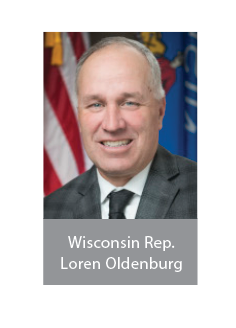‘Earn and learn’: State support for youth apprenticeships is growing; Wisconsin already is a national leader
Last school year, more than 5,000 Wisconsin high school juniors and seniors earned $28.7 million while they learned on the job — all while securing academic credits for high school graduation and often getting a jump-start on a postsecondary program.
They did so by participating in the state’s nationally recognized youth apprenticeship program. In his home district, Rep. Loren Oldenburg has seen young people take advantage of this “earn and learn” opportunity by working in the mechanics shop of a local auto dealer or by getting early, hands-on experience in careers such as agriculture, manufacturing, hospitality and banking.
“Here in our rural areas, we can get our young adults into the workforce sooner, and in career areas that they might like,” he says. “And that can be the difference in them staying here.” Wisconsin is ahead of most states on youth apprenticeship. Its program dates back 30 years, with state policy and grants providing the foundation for coalitions of school districts, labor organizations and industry groups to work on locally run initiatives. The idea is catching on in other states.
In a recent web event of The Council of State Governments’ Midwestern Legislative Conference, lawmakers learned how states such as Iowa and Michigan are making a greater commitment to youth apprenticeship.
In Iowa, it began as a pilot project in one high school in 2018, and has since expanded to 60 schools covering 19 different occupational areas. The Legislature is now appropriating nearly $4 million to help start or maintain local youth apprenticeships, and it also passed a bill in 2021 (HB 847) giving school districts greater funding flexibility to share the costs of employing work-based learning coordinators.
Michigan, long a policy leader on registered apprenticeships for adults, is now making similar opportunities available to 16- to 24-year-olds.
As part of a federal grant, Michigan has secured $5 million to build what it is calling a “youth apprenticeship readiness network” of schools, employers, and labor and business organizations. Together, these groups will create more than 1,000 new youth apprenticeships. The state wants at least 124 of the participants to be youths with disabilities. These young Michigan apprentices will earn industry-recognized credentials in sectors that need more skilled workers and that offer pathways to high-wage careers. (Examples include advanced manufacturing, construction, energy, health care and information technology.)
In Wisconsin, state-level support comes first and foremost from a $6 million grant program overseen by the Department of Workforce Development. Legislators have developed a list of 16 career clusters that must be offered to students, and state statute also sets performance targets for grant recipients: for example, at least 60 percent of the students should be offered a job at the place where they received two years of on-the-job training.
Since joining the Legislature, Oldenburg has prioritized an expansion of youth apprenticeship, and he says two recent legislative actions will help. First, Wisconsin raised the reimbursement rate for local programs from $900 to $1,100 per apprentice. Second, the recently enacted AB 220 (sponsored by Oldenburg) requires schools with a youth apprenticeship program to provide information about it to parents and students.